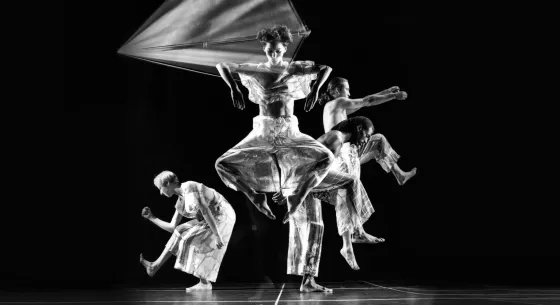“Dancing with Bob”: A Celebration of Trisha Brown, Merce Cunningham & Robert Rauschenberg’s Creative Collaborations

Trisha Brown Dance Company With Merce Cunningham Trust: Dancing with Bob: Rauschenberg, Brown & Cunningham Onstage honors the centennial of art legend Robert (Bob) Rauschenberg, who the Walker Art Center describes as a “perpetual and intentional novice, moving between media and often changing his practice as soon as working in a certain way became too easy for him.”
The Tue, Nov 11, 7:30 pm performance at Northrop will showcase Rauschenberg's distinctive visual presentation and celebrate iconic 20th century artists, including Trisha Brown's acclaimed Set and Reset, set to music by Laurie Anderson; and Merce Cunningham's comedic pièce de résistance, Travelogue, a masterpiece rarely seen by the public since 1979, with music by John Cage.
Top image: Merce Cunningham Dance Company in Travelogue (1977). Photograph by Charles Atlas. Courtesy of the Merce Cunningham Trust and the Jerome Robbins Dance Division, The New York Public Library.
A Closer Look

Rauschenberg designs a unicorn costume for his sister Janet, modeled by fellow student Inga (Ingeborg) Lauterstein at Black Mountain College, circa 1949. Photo by Trude Guermonprez, Photograph Collection. Robert Rauschenberg Foundation Archives, New York.
Rauschenberg’s Early Life & Influences
Merce Cunningham Dance Company. Photo © Charles Atlas. Excerpts from Trisha Brown Dance Company performing Travelogue (1977) at the American Dance Festival in Durham, NC, 2025. Video courtesy American Dance Festival.
Collabs With Cunningham & Cage

Trisha Brown, Robert Rauschenberg, Burt Barr, and others at Larry B. Wright Art Productions working on costumes for Trisha Brown Dance Company’s Set and Reset (1983), 1983. Photo courtesy of Robert Rauschenberg Foundation.
Trisha Brown’s Influence

Trisha Brown Dance Company, Glacial Decoy, 1979. Photo by Boyd Hagen, courtesy of Walker Art Center.
The Walker & Minneapolis Connection
Trisha Brown Dance Company. Photo © Mark Hanauer. Excerpts from Trisha Brown Dance Company performing Set and Reset (1983) at the American Dance Festival in Durham, NC, 2025. Video courtesy American Dance Festival.

Rauschenberg with a portion of his 29-panel installation work A Quake in Paradise (Labyrinth) (1994), exhibited at the Mekhitarian Monastery of Saint Lazarus, Isle of San Lazzaro degli Armeni, Venice, summer 1996. Photo © Graciano Arici.
Rauschenberg’s Legacy
Acknowledgments
This activity is made possible by the voters of Minnesota through a Minnesota State Arts Board Operating Support grant, thanks to a legislative appropriation from the Arts and Cultural Heritage Fund.


